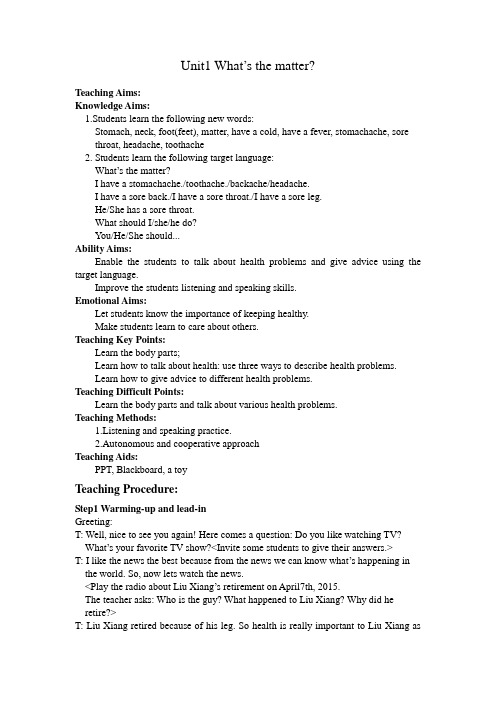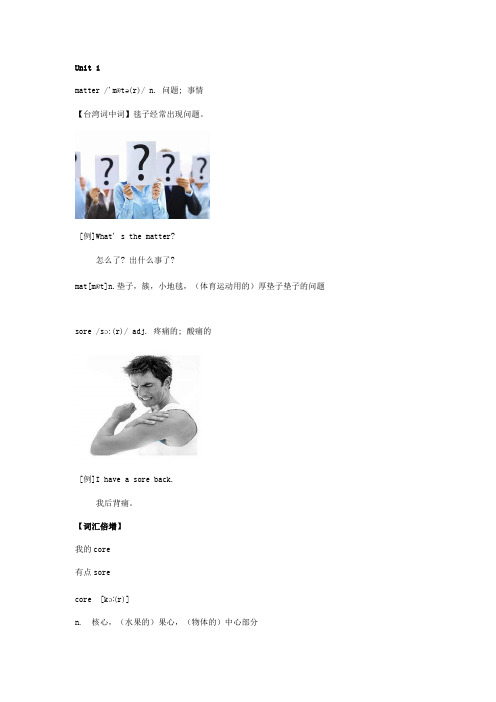人教版初中英语8年级下册 Unit 1 What's the matter?单元教案
- 格式:doc
- 大小:154.50 KB
- 文档页数:24

八年级下册英语Unit 1 what’s the matter?词汇篇学生通过本讲学习,能够掌握本单元的重点词汇句型,并在综合能力上有一定的拓展。
1.matter的用法(1)名词:事情,问题What’s the matter? =what’s wrong (with you)? =what’s the trouble怎么啦?出什么事啦?(2)动词:有重大影响,有重要性如:What does it matter?2.疾病的表达法have a cold/a fever/ a toothache/ a stomachache3.take 的固定搭配take one’s temperature/ take breaks/ take risks/take some medicine/take off/ take care of/take away 4.surprise的用法1.做名词:to one’s surprise 使。
惊讶的,出乎。
意料2.做动词:surprise sb使某人吃惊3.做形容词:surprising, surprised的用法5.get的用法get off下车/get on上车/get into陷入,参与6.be used to sth/doing sth 习惯于做某事be used to do sth 被用作去做某事used to do sth 习惯于做某事7.out of的固定搭配look out of 向。
外看/ get out of从。
出来/ run out of用光基础演练1.---What’s wrong ______you?---I fell off the bike and hurt my leg.A. ofB. withC. forD. by2.Tom and Jenny enjoyed _________playing computer games.A. himselfB. herselfC. ourselvesD. themselves3. Sally became interested ___________science and wanted to be a scientist.A. forB. inC. throughD. at4. ---I had a __________.---You’d better go to see a dentist.A. headacheB. feverC. coldD. toothache5. I didn’t _________my temperature, but I knew I had a fever.A. giveB. setC. takeD. show二、根据汉语意思翻译句子。

Unit1 What’s the matter?Teaching Aims:Knowledge Aims:1.Students learn the following new words:Stomach, neck, foot(feet), matter, have a cold, have a fever, stomachache, sore throat, headache, toothache2. Students learn the following target language:What’s the matter?I have a stomachache./toothache./backache/headache.I have a sore back./I have a sore throat./I have a sore leg.He/She has a sore throat.What should I/she/he do?You/He/She should...Ability Aims:Enable the students to talk about health problems and give advice using the target language.Improve the students listening and speaking skills.Emotional Aims:Let students know the importance of keeping healthy.Make students learn to care about others.Teaching Key Points:Learn the body parts;Learn how to talk about health: use three ways to describe health problems.Learn how to give advice to different health problems.Teaching Difficult Points:Learn the body parts and talk about various health problems.Teaching Methods:1.Listening and speaking practice.2.Autonomous and cooperative approachTeaching Aids:PPT, Blackboard, a toyTeaching Procedure:Step1 Warming-up and lead-inGreeting:T: Well, nice to see you again! Here comes a question: Do you like watching TV? What’s your favorite TV show?<Invite some students to give their answers.>T: I like the news the best because from the news we can know what’s happening in the world. So, now lets watch the news.<Play the radio about Liu Xiang’s retirement on April7th, 2015.The teacher asks: Who is the guy? What happened to Liu Xiang? Why did he retire?>T: Liu Xiang retired because of his leg. So health is really important to Liu Xiang aswell as to us. In this class we are going to talk about health problems and give advice. Step2 While-taskTask 1 Can you name the body parts? the body parts.(1)T: We have learned the word before class. Now I want to have a check. There isa Mickey Mouse. Can you name her body parts?<Invite two students to name Mickey’s body parts.>(2)Show a cartoon picture and ask the students to tell his body parts one by one.Give the students 30seconds to read these words and keep in mind.Read all the words after the teacher and touch their body parts as they read.2.Game Time: Touch your …(1)Two students as a group, one say and one touch.(2)Five students as a group, one say and four touch.3.PracticeWork on Section A 1a students say one by one.Check the answers(Students in group1 tell the answers one by one and the rest of the students read the words together)Task 2 What’s the matter? Say different illnesses1.T: Well, different parts of the body may have different illnesses, for example ... (1) Show some pictures with different illnesses and ask the students to tell what these illnesses are : have a cold; have a fever; have a headache; have a sore back; have a sore throat; have a stomachache; have a toothache.(2) Read these words after the teacher and then read by themselves to keep in mind.2.T: These are all about illnesses, but how to ask about the illness, we can say:What's the matter?/ What's the matter with you?/What's wrong?/What's wrong with you?/What's your trouble?/What's up?(Invite the Ss to read these sentences) (1)Teach the three ways of having a problem by making dialogues with the students. And at the same time, show some pictures about these illnesses.Eg: A: What’s the matter? B: I have a...(have a+疾病;have a+部位+ache; have+sore+身体部位)(2)Pair workT: Good, just now we have learned how to ask about your illness and how toanswer it. Now let’s make conversation with “What’s the matter?” and “I havea...” OK?<Invites some pairs to make their conversations in front of the class.>T: This time let’s do it one by one in your group. The first one asks the second one until to the last one. Let’s see which group is the first one to finish.<Invite the winner to show their result.>3.Listening practiceListen to the sound and check the answers:312544.Practice what’s the matter with he/she?(1)Ask three students: What’s the matter with you? Then ask the rest of the students: What’s the matter with he/she?(2)Look at some pictures to make conversationsThe boys ask “What’s the matter with he/she?” and the girls answer “He/She hasa...”(3) Game timeOne student mimes (模拟)an illness. One student guesses and the rest of the students ask: What's the matter with he/she?Task3 Give some advice(1)T: If someone has an illness we ask: What’s the matter?” And sometimes we alsogive some advice. How to five advice? We need one word: should.Show the PPT and explain it.(2)Teach some advice to five different illnesses by making dialogues.(3)Pair work: Invite some students to make conversations.(4)Game time: Who is the best patient(病人) and who is the best doctor?Make conversations between a doctor and some patient to see who is the best. Step3 PracticeDo some exercise for consolidation.Step4 SummaryT: During this class, we learned how to ask about illness and how to give advice.Let’s have a look. (Show the PPT to see what have learned.)T: Finally there are two sentences for you, “An apple a day keeps the doctor away.He who has good health is young, and he is rich who owes nothing.” I wish all of you happy and healthy everyday and keep away from illness. Thank you!。

人教版英语八年级下册第一单元知识点过关Unit 1 What’s the matter?一、重点短语1. have a fever 发烧,具体运用:She has a fever and she should lie down and rest.2. have a cough 咳嗽,cough既可以作名词,也可以作动词3. have a toothache 牙疼;tooth牙齿+ ache疼痛toothache 牙痛4. talk too much 说得太多;类似短语:eat too much吃太多5. drink enough water 喝足够的水;take enough money带够钱6. have a cold 受凉、感冒;也可以用catch a cold7. have a stomachache 胃疼;stomach胃+ache疼痛stomachache 胃疼8. have a sore back 背疼;sore疼痛+back背sore back背疼9. have a sore throat 喉咙痛10. lie down and rest 躺下休息11. hot tea with honey 加蜂蜜的热茶;with表示“带有”12. see a dentist 看牙医;看医生用“see”13. get an X-ray 拍X 光片14. take one’ s temperature 量体温;量体温、服药都用“take”15. put some medicine on sth. 在……上面敷药;例如:put some medicine on the cut在切口处敷药16. feel very hot 感到很热;feel感官动词,后接形容词17. sound like 听起来像;例如:sounds like a good idea 听起来像个好主意18. all weekend 整个周末;类似短语:all day \ all night \ all month19. in the same way 以同样的方式20. go to a doctor 看医生21. go along 沿着……走;类似短语:walk along22. on the side of the road 在马路边23. shout for help 大声呼救24. without thinking twice 没有多想;without是介词,后接动词ing形式25. get off 下车;反义词get on上车26. have a heart problem 患有心脏病27. to one’ s surprise 使....... 惊讶的;例如:to my surprise \ to his surprise28. thanks to 多亏了、由于;例如:Thanks to the the doctors , the patient was saved in time. 多亏了医生们,这个病人及时被救了。

Unit 1matter /'mætə(r)/ n. 问题; 事情【台湾词中词】毯子经常出现问题。
[例]What' s the matter?怎么了? 出什么事了?mat[mæt]n.垫子,簇,小地毯,(体育运动用的)厚垫子垫子的问题sore /sɔ:(r)/ adj. 疼痛的; 酸痛的[例]I have a sore back.我后背痛。
【词汇倍增】我的core有点sorecore [kɔː(r)]n. 核心,(水果的)果心,(物体的)中心部分have a cold 感冒[例]I have a cold.我感冒了。
stomachache /'stʌməkeɪk/ n. 胃痛; 腹痛have a stomachache 胃痛[例]I have a stomachache.我胃痛。
【英国字母索源法】stomach(胃)+ache(痛)foot /fʊt/ n. 脚; 足【英国字母索源法】f代表“五官”[例]One of my feet is dirty.我的一只脚脏了。
neck /nek/ n. 颈; 脖子【英国字母索源法】n代表“细长”[例]The neck of the glass is dirty.杯颈脏了。
stomach /'stʌmək/ n. 胃; 腹部[例]what a stomach he has got !他可真是个大腹便便的人!【脑图单词速记】蛇s吐to马ma吃chthroat /θrəʊt/ n. 咽喉; 喉咙 p.1【英国字母索源法】thr代表“三”throat喉咙--通向三处,Third第三 thirteen十三 thirty三十。
[例]She has a very sore throat now.她现在嗓子疼的很厉害。
【词汇倍增】一只goat(山羊)穿件coat(衣服)上了boat(船)掉进moat(城壕)摔断throat (喉咙)fever /'fi:və/ n. 发烧[例] She has a fever.她发烧了。


《Unit 1 Unit 1 What’s the matter?》教案教学目标:1语言目标:描述健康问题的词汇,及如何根据别人的健康问题提建议。
2 技能目标:能听懂谈论健康问题的对话材料;能根据别人的健康问题提建议;能写出重点单词和重点句型,并能描述怎样对待健康问题。
3 情感目标:通过开展扮演病人等活动,培养学生关心他人身体健康的品质。
通过本课的阅读,培养学生处理紧急事件的基本能力,树立紧急事件时互相帮助的精神。
Section A 1 (1a – 2d)Step 1 Warming up and new words1.Look at a picture and learn the parts of the body.2.New words and phrases.Step 2 Presentation1a Look at the picture. Write the correct letter [a-m] for each part of the body.___arm ___ back ___ ear ___ eye ___ foot___hand ___ head ___ leg ___ mouth___ neck ___nose ___ stomach ___ toothStep 3 Listening1b Listen and look at the picture. Then number the names 1-5Listen to the conversations again and fill in the blanks.Conversation 1Nurse: What’s the matter, Sarah?Girl: I ___________.Conversation 2Nurse: What’s the matter, David?Boy: I _________________.Conversation 3Nurse: What’s the matter, Ben?Boy: I _________________.Conversation 4Nurse: What’s the matter, Nancy?Girl: I _________________.Conversation 5Betty: What’s the matter, Judy?Ann: She __________________.Step 4 Speaking1c Look at the pictures. What are the students’ problems? Make conversati ons.ExamplesA: What’s the matter with Judy?B: She talked too much yesterday and didn’t drink enough water.She has a very sore throat now.A: What’s the matter with Sarah?B: She didn’t take care of herself on the weekend. She was p laying withher friends at the park yesterday. Then it got windy, but she didn’t puton her jacket. Now she has a cold.Step 5 Guessing gamesGuess what has happened to the students by using the important sentenc es. Step 6 Listening2a Listen and number the pictures [1-5] in the order you hear them.2b Listen again. Match the problems with the advice.Step 7 Speaking2c Make conversations using the information in 2a and 2bA: What’s the matter?B: My head feels very hot.A: Maybe you have a fever.B: What should I do?A: You should take your temperature.Step 8 Role–playImagine you are the school doctor. A few students have health problems.Role-play a conversation between the doctor and the students.2d Role –play the conversationStep 9 Language points and summary1. What’s the matter?这是人们特别是医生和护士询问病人病情时最常用的问句, 意思是“怎么了?”其后通常与介词with连用。
人教版八年级下册英语课本知识点梳理Unit 1 wh at’s the matter? sectionA课文内容:What's the matter? 怎么了? (教材第1页)【用法详解】What's the matter? 怎么了?/出什么事了?常用于询问某人患了何种疾病,遇到了什么困难等,也可用于询问某物出了什么故障,其后可接with sb./sth.,表示“某人/某物怎么了?”。
其中matter 用作名词,意为“问题;事情”matter前须加定冠词the。
【例句】What's the matter? 怎么了?Bad luck.I lost my pen. 真倒霉,我弄丢了钢笔.What's the matter with him? 他怎么了?He has a sore back.他背痛【拓展】matter[动词] 要紧;有关系多用在否定句、疑问句或条件句中It doesn't matter.没关系。
(通常用来回答对方的道歉)I have a cold. 我感冒了。
(教材第1页)【用法详解】have a cold (患)感冒。
其中have 用作及物动词,意为“患(病);遭受(病痛)”,常用于结构“have a/an +疾病名称”表示患病或身体某部位不舒服。
此时它不能用于进行时态,其第三人称单数形式为has,过去式为had。
常见的表示病痛的短语还有:have a fever 发烧have a toothache 牙疼have a headache头痛have a cough 咳嗽have a stomachache胃痛Do you often have a cold? 你经常感冒吗?Jim had a stomachache after supper yesterday.吉姆昨天晚饭后胃痛。
l have a stomachache.我胃痛。
( 教材第1 页)【用法详解】stomachache [名词]胃痛;腹痛是由“名词stomach(;腹部)+ache(疼痛)”构成的复合名词。
Unit 1 What’s the matter?
教材分析:
本单元是改版后的八年级下册英语教材的第一个单元。
主要讨论的话题是询问某人的健康状况以及遇到麻烦的表达方法。
本单元涉及到大量的表示人体部分的单词以及关于身体某部位不舒服的短语。
此外,本单元还涉及到党当人身体不适时,医生、朋友或亲人提出的意见的表达法。
本单元共有阅读类文章两篇,文章的主体时态都为一般过去时。
主要句型为.What’s the matter with…?”“What should I/ you/ he/ she/they… do?”“I/ you/ he/
she/they should do…?”“I have a headache/stomachache/toothache.” “Does she/he/ have a fever/cold/toothache…?”总的来说,本单元的相关语法知识并不难。
教学目标:
1.知识目标:
(1)掌握一些相关的词和词组:matter, sore, have a cold, foot, neck, stomach, throat, fever, lie, lie down, rest, cough, toothache, headache, break, hurt, passenger, get off, to one’s surprise, trouble, get into, climber, be used to, sick, risk, herself, sunburned等;
(2)掌握反身代词的用法;enjoy oneself, help oneself to,
(3)掌握情态动词should的用法;
(4)掌握以下主要句型:
. What’s the matter with…?”
“What should I/ you/ he/ she/they… do?”
“I/ you/ he/ she/they should do…”
“I have a headache/stomachache/toothache.”
“Does she/he/ have a fever/cold/toothache…?”
2.能力目标:
1.能够用英语询问某人的身体状况以及关心他人是否遇到麻烦;
2.提高学生合作学习、自主学习的能力。
3.并能熟练运用所学知识就过去活动进行描述,学生听说读写的能力得到提高。
4.会使用部分情态动词;
情感目标: 1.教会学生关心他人,培养同学间团结、友善的精神。
2.通过本单元的学习能引导学生关注自己及身边人的身体健康、并学习如何去关心他人及提出适当的建议。
3.能使学生意识到要如何去保持健康并养成良好的生活习惯。
4.培养学生主动救助处于危险境地的人的精神,在紧急关头,有勇气做出正确的决定。
此外,生活中遇到困境,需要有坚强的意志力去面对一切。
教学难点:掌握情态动词should \shouldn’t. 的用法
学习have的用法
课时划分:
Section A1 1a – 2d
Section A2 3a-3c
Section A3 Grammar Focus-4c
Section B1 1a-2e
Section B2 3a-Self check
Section A 1 (1a – 2d)
Step 1 Warming up and new words
1.Look at a picture and learn the parts of the body.
2.New words and phrases.
Step 2 Presentation
1a Look at the picture. Write the correct letter [a-m] for each part of the body.
___arm ___ back ___ ear ___ eye ___ foot
___hand ___ head ___ leg ___ mouth
___ neck ___nose ___ stomach ___ tooth
Step 3 Listening
1b Listen and look at the picture. Then number the names 1-5
Listen to the conversations again and fill in the blanks.
Conversation 1
Nurse: What’s the matter, Sarah?
Girl: I ___________.
Conversation 2
Nurse: What’s the matter, David?。